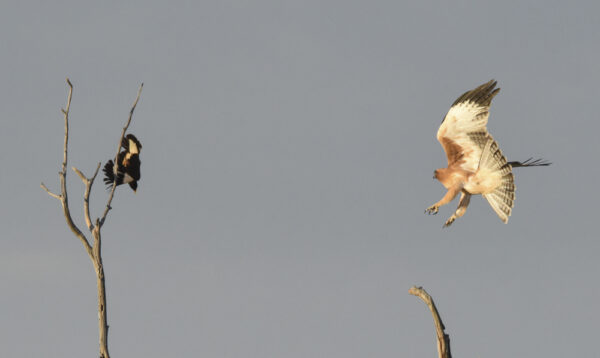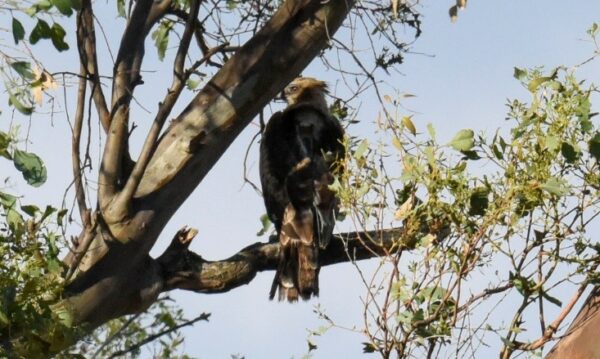Little Eagle soars on new findings
Good news this week on the Little Eagle front, with the finding that the ACT had more breeding pairs active in 2017-18 than recorded in recent years. The ACT Conservator for Flora and Fauna announced the findings coming out of collaborative research.
The research effort to monitor the threatened Little Eagle found at least nine nesting pairs in the ACT during the 2017–18 breeding season, with a record four chicks being reared according to Conservator for Flora and Fauna, Ian Walker.
“Six of the pairs laid eggs and four chicks were reared – one each from two nests and two from another. This is the highest annual number of egg-laying pairs recorded in recent years in the ACT,” Mr Walker said.
“Although this does reflect a greater search effort, it is nevertheless exciting and indicates that the eagle is doing better than we feared.”

Above: Juvenile responds to a mobbing by Common Myna birds near Strathnairn on 27 January 2017. Photo source: Stuart Rae.
“The researchers also observed another two pairs of Little Eagles, but breeding activity was not confirmed. Two nesting pairs in nearby NSW also hatched chicks.”
“All these nesting areas will be monitored in future to build a thorough knowledge of the breeding ecology of Little Eagles in the ACT and surrounding NSW so we can help maintain a long-term viable population of the eagles in our district,” Mr Walker said.
The research group includes researchers from the Australian National University, ACT Government, CSIRO and the Ginninderry development project. It was recently joined by a Little Eagle researcher from the University of New England.

Above: This adult male pictured near Strathnairn on 27 January 2017 flew to the Nothern Territory about five weeks later. Photo source: Stuart Rae.
“Live webcams were installed above one of the nests prior to the breeding season to record the eagles’ nesting habits and breeding behavior,” Mr Walker said.
“A pair of eagles took possession of the nest and added fresh material. The male fed the female on the nest and they mated. As many eagles of various species do, the pair then switched nests to lay their eggs about two kilometres away.”
“Of the four chicks that were raised, one female was fitted with a tracking tag in December. The team has been eagerly following her by satellite. She moved increasing distances from her nest as she grew older and stronger, flying over urban areas and visiting several urban nature reserves, sometimes flying up to 7 kilometres from her nest area and more than 800 metres above street level.”
“Then, on 11 March, at less than 6 months old, she literally flew the nest and is now 1000 kilometres away in south-east Queensland. It will be interesting to see where she goes next and whether she’ll return to Canberra,” Mr Walker said.
